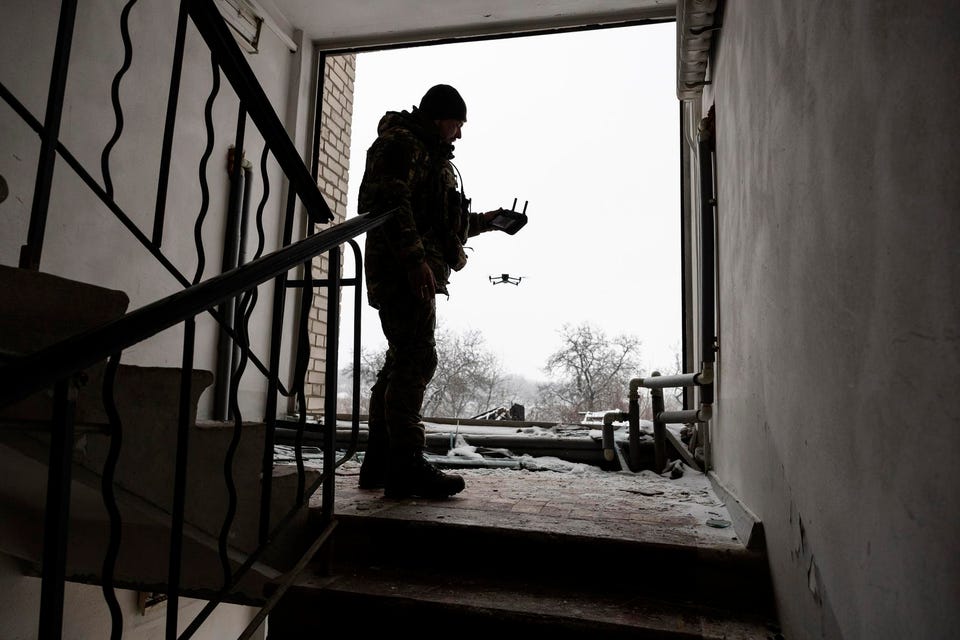Ukraine Is Spoofing Russian Drones Out Of The Sky

A new type of electronic warfare is bringing Russian drones crashing to the ground by fooling their guidance systems.
Radio-frequency jamming has become ubiquitous in Ukraine as both sides seek to prevent the other from using drones. Typically two type of electronic warfare are employed: generating radio noise to interfere with the control signal, making it impossible to pilot the drone, and blasting interference on GPS frequencies so the drone’s satellite navigation fails. Now a third technique has been observed: navigation spoofing.

The Coordination Center for Assistance to Novorossia (occupied Ukraine) is run by Russian-backed militia organisation which publishes articles on military topics. On January 14th they ran a piece describing how the rate of drone losses had increased alarmingly.
“In three days, the scouts of the 5th brigade in the area south of Krasnohorivka lost five quadcopters: three DJI Mavic 3 and two Autel EVO VO 2 Dual. They were lost in the same situations: at first all the [navigation] satellites disappeared, after a short period of time the satellites appeared, and immediately the quadcopters descended rapidly, at a rate comparable to falling,” writes the anonymous author.
The operators eventually figured out what was going on. The drones had been fooled into thinking they were in a no-fly zone, and had ceased operating. Drone makers like DJI and others employ a method known as geofencing to ensure their drones are not flown in prohibited areas such as around airports: a virtual fence surrounds every defined no-fly zone and the drone will not fly inside it. Ukrainian electronic warfare had tricked the Russian drones into crashing.
GPS spoofing is a well-established technique; in 2013 Prof Todd Humphreys gave a demonstration of how a large yacht could be virtually hijacked by feeding false navigation data so it would sail wherever he wanted without the crew being aware they were off course. Russia makes use of spoofing in its defenses. Drivers in Moscow find their satnav thinks they are thousands of miles away, and a bubble of GFPS spoofing surrounds Putin, apparently protection against drone attacks. The navigation systems of ships in the Black Sea show them at Gelendzhik Airport, 20 miles inland, assumed to be the result of Russian electronic warfare.
(There are other satellite navigation systems, including Europe’s Galileo, Russia’s GLONASS and the Chinese BeiDou, but for convenience the term GPS spoofing is used to cover deception of any satellite navigation system).
Dana Goward, resident of the Resilient Navigation and Timing Foundation, told Forbes that the report of crashing drones bore the hallmarks of satnav being fooled.
“Pretty clearly a spoofing scenario,” said Goward.
Goward noted that the Russians had likely used GPS spoofing before in Ukraine, judging from reports by the Organization for Security and Co-operation in Europe’s Special Monitoring Mission. But this may be the first time the tables had been turned. The Ukrainians’ technology may even have originated in Russia.
“Russia has been bragging about spoofing since 2016 so no reason to think they haven’t been exporting it,” says Goward.
The Russian drone operators note that the spoofing can be overcome by switching the drone to manual piloting mode so it does not rely on GPS signals, but this needs to be done quickly before it falls to earth.
“Quadcopter losses have increased dramatically under the circumstances described above. From the second of January … the scouts of the 5th brigade began to fly only in manual mode,” according to the article.
They warn also that the technique appears to be spreading fast, threatening drone users in other areas.
“We can cite information dated 02.01.23, posted in the telegram channel ‘Karkusha’ of the drone operator fighting in the Luhansk direction…it describes the appearance of spoofing on that part of the front… the problems associated with the strengthening of the enemy’s electronic warfare in the Krasnogorovka area will sooner or later affect all our quadcopter users.”
They also note that even when the drone is in manual mode it may still crash if it does not get out of the area affected fast enough.
While the spoofing adds a new twist, it simply highlights the fact that consumer drones are highly vulnerable to interference of all sorts. Anti-drone electronic devices are becoming increasingly common on both sides. Some believe this will make quadcopters, now widely used, increasingly ineffective.

“So actually, I believe like in three, four months, DJI will not be usable,” a Ukrainian drone specialist told The Guardian this month.
More advanced drones with jam-resistant receivers to filter out radio noise, and which can use the military M-code GPS signal will keep flying though. Ukrainian kamikaze drones already appear to be overcoming Russian GPS jamming. And while Ukraine has a healthy ecosystem of startups producing advanced drones for the battlefield, Russia’s drone procurement process struggles with inertia, corruption, and its continuing reliance on Western electronics.
We also need to consider the bigger picture. GPS warfare is now mainstream, with spoofing now spreading. The technology is known and it will not long be confined to armed forces and state actors. Given how heavily the civilian world relies on satellite navigation and timing, we need to start thinking seriously about backup systems. Otherwise if our GPS stops working or, worse, gets hijacked by the sort of spoofing technology now becoming widespread in Ukraine, our transport systems may stop working as dramatically as those Russian quadcopters.
